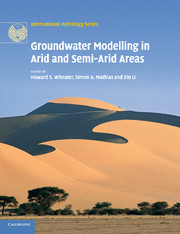Book contents
- Frontmatter
- Contents
- Contributors
- Preface
- Acknowledgements
- 1 Groundwater modelling in arid and semi-arid areas: an introduction
- 2 Hydrological processes, groundwater recharge and surface-water/groundwater interactions in arid and semi-arid areas
- 3 Conceptual models for recharge sequences in arid and semi-arid regions using isotopic and geochemical methods
- 4 Groundwater flow and transport
- 5 Performing unbiased groundwater modelling: application of the theory of regionalised variables
- 6 Groundwater vulnerability and protection
- 7 Variable density groundwater flow: from modelling to applications
- 8 Sustainable water management in arid and semi-arid regions
- Index
- Plate section
- References
5 - Performing unbiased groundwater modelling: application of the theory of regionalised variables
Published online by Cambridge University Press: 06 December 2010
- Frontmatter
- Contents
- Contributors
- Preface
- Acknowledgements
- 1 Groundwater modelling in arid and semi-arid areas: an introduction
- 2 Hydrological processes, groundwater recharge and surface-water/groundwater interactions in arid and semi-arid areas
- 3 Conceptual models for recharge sequences in arid and semi-arid regions using isotopic and geochemical methods
- 4 Groundwater flow and transport
- 5 Performing unbiased groundwater modelling: application of the theory of regionalised variables
- 6 Groundwater vulnerability and protection
- 7 Variable density groundwater flow: from modelling to applications
- 8 Sustainable water management in arid and semi-arid regions
- Index
- Plate section
- References
Summary
INTRODUCTION
Groundwater in arid and semi-arid regions is increasingly over-exploited because of high population growth and extensive agricultural application. It is essential to have a thorough understanding of the complex processes involved when undertaking groundwater assessment and management activities. Groundwater models play an important role due to their ability to estimate head distributions and flow rates for possible future scenarios. These models are computer-based numerical solutions to the boundary value problems of concern.
There is no doubt that the mathematical and computational aspect of groundwater modelling has reached a satisfactory level of development. Therefore, the focus of research in recent years has shifted to the problems of parameter identification and uncertainty quantification. Hydrogeological parameters display a large spatial heterogeneity, with possible variations of several orders of magnitude within a short distance. This spatial variability is difficult to characterise in a deterministic way. However, a statistical analysis shows that hydrogeological parameters do not vary in space in a purely random fashion. There is some structure to this spatial variability that can be characterised in a statistical way.
During the last few decades, numerous mathematical approaches have been used to estimate hydrogeological parameters from scattered or sparse data. The study of regionalised variables starts from the ability to interpolate a given field from only a limited number of observations while preserving the theoretical spatial correlation. This is accomplished by means of a geostatistical technique called kriging.
- Type
- Chapter
- Information
- Groundwater Modelling in Arid and Semi-Arid Areas , pp. 63 - 74Publisher: Cambridge University PressPrint publication year: 2010
References
- 1
- Cited by



